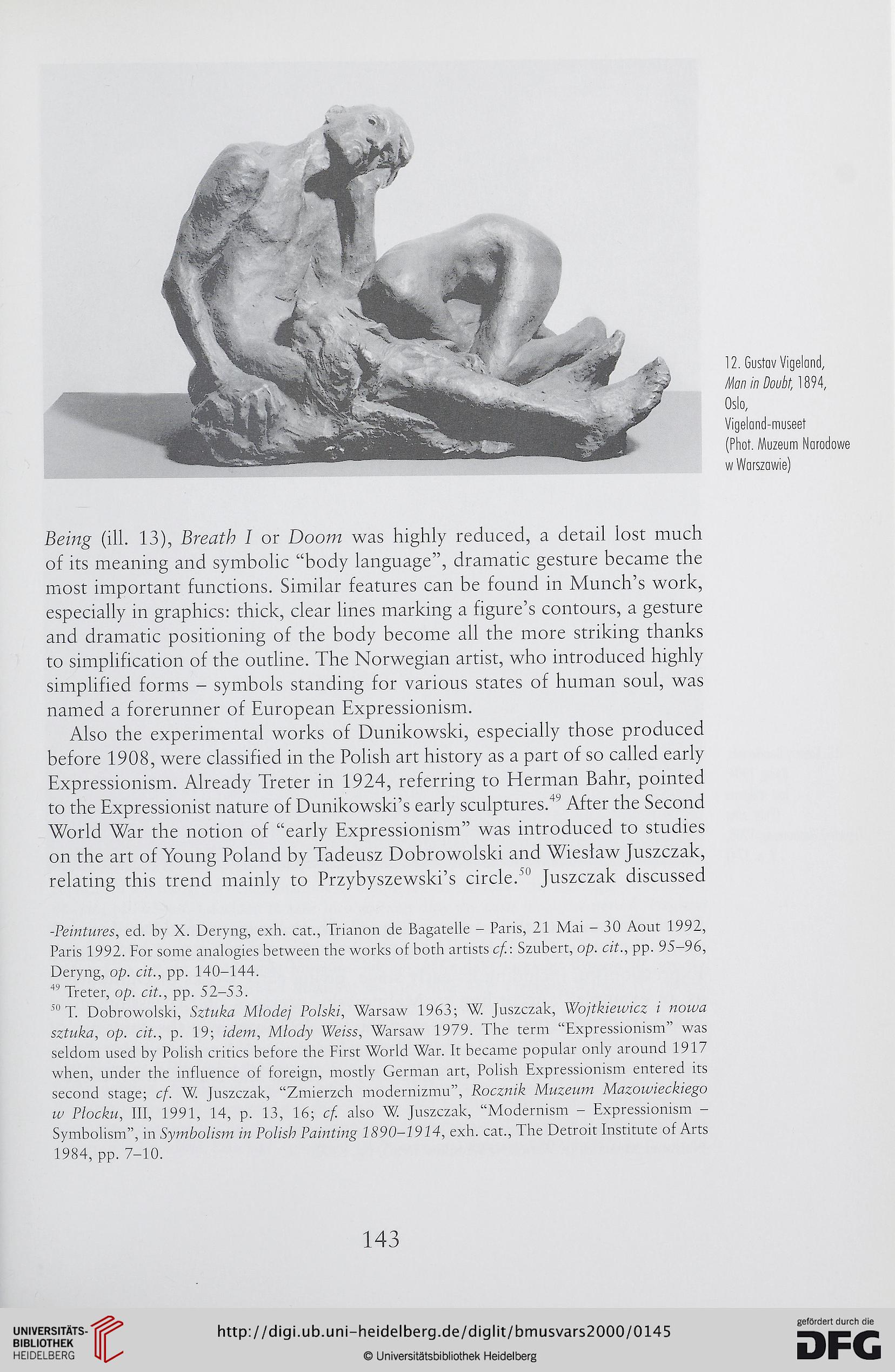12. Gustav Vigeland,
Man in Doubt, 1894,
Oslo,
Vigeland-museet
(Phot. Muzeum Narodowe
w Warszawie)
Being (ill. 13), Breath I or Doom was highly reduced, a detail lost much
of its meaning and symbolic “body language”, dramatic gesture became the
most important functions. Similar features can be found in Munch’s work,
especially in graphics: thick, elear lines marking a figure’s contours, a gesture
and dramatic positioning of the body become all the morę striking thanks
to simplification of the outline. The Norwegian artist, who introduced highly
simplified forms - symbols standing for various States of human soul, was
named a forerunner of European Expressionism.
Also the experimental works of Dunikowski, especially those produced
before 1908, were classified in the Polish art history as a part of so called early
Expressionism. Already Treter in 1924, referring to Herman Bahr, pointed
to the Expressionist naturę of Dunikowskie early sculptures.49 After the Second
World War the notion of “early Expressionism” was introduced to studies
on the art of Young Poland by Tadeusz Dobrowolski and Wiesław Juszczak,
relating this trend mainly to Przybyszewskie circle.5'1 Juszczak discussed
-Peintures, ed. by X. Deryng, exh. cat., Trianon de Bagatelle - Paris, 21 Mai - 30 Aout 1992,
Paris 1992. For some analogies between the works of both artists cf.: Szubert, op. cit., pp. 95-96,
Deryng, op. cit., pp. 140-144.
49 Treter, op. cit., pp. 52-53.
T. Dobrowolski, Sztuka Młodej Polski, Warsaw 1963; W Juszczak, Wojtkiewicz i nowa
sztuka, op. cit., p. 19; idem, Młody Weiss, Warsaw 1979. The term “Expressionism” was
seldom used by Polish critics before the First World War. It became popular only around 1917
when, under the influence of foreign, mostly German art, Polish Expressionism entered its
second stage; cf. W. Juszczak, “Zmierzch modernizmu”, Rocznik Muzeum Mazowieckiego
w Płocku, III, 1991, 14, p. 13, 16; cf. also W Juszczak, “Modernism - Expressionism -
Symbolism”, in Symbolism in Polish Painting 1890-1914, exh. cat., The Detroit Institute of Arts
1984, pp. 7-10.
143
Man in Doubt, 1894,
Oslo,
Vigeland-museet
(Phot. Muzeum Narodowe
w Warszawie)
Being (ill. 13), Breath I or Doom was highly reduced, a detail lost much
of its meaning and symbolic “body language”, dramatic gesture became the
most important functions. Similar features can be found in Munch’s work,
especially in graphics: thick, elear lines marking a figure’s contours, a gesture
and dramatic positioning of the body become all the morę striking thanks
to simplification of the outline. The Norwegian artist, who introduced highly
simplified forms - symbols standing for various States of human soul, was
named a forerunner of European Expressionism.
Also the experimental works of Dunikowski, especially those produced
before 1908, were classified in the Polish art history as a part of so called early
Expressionism. Already Treter in 1924, referring to Herman Bahr, pointed
to the Expressionist naturę of Dunikowskie early sculptures.49 After the Second
World War the notion of “early Expressionism” was introduced to studies
on the art of Young Poland by Tadeusz Dobrowolski and Wiesław Juszczak,
relating this trend mainly to Przybyszewskie circle.5'1 Juszczak discussed
-Peintures, ed. by X. Deryng, exh. cat., Trianon de Bagatelle - Paris, 21 Mai - 30 Aout 1992,
Paris 1992. For some analogies between the works of both artists cf.: Szubert, op. cit., pp. 95-96,
Deryng, op. cit., pp. 140-144.
49 Treter, op. cit., pp. 52-53.
T. Dobrowolski, Sztuka Młodej Polski, Warsaw 1963; W Juszczak, Wojtkiewicz i nowa
sztuka, op. cit., p. 19; idem, Młody Weiss, Warsaw 1979. The term “Expressionism” was
seldom used by Polish critics before the First World War. It became popular only around 1917
when, under the influence of foreign, mostly German art, Polish Expressionism entered its
second stage; cf. W. Juszczak, “Zmierzch modernizmu”, Rocznik Muzeum Mazowieckiego
w Płocku, III, 1991, 14, p. 13, 16; cf. also W Juszczak, “Modernism - Expressionism -
Symbolism”, in Symbolism in Polish Painting 1890-1914, exh. cat., The Detroit Institute of Arts
1984, pp. 7-10.
143




